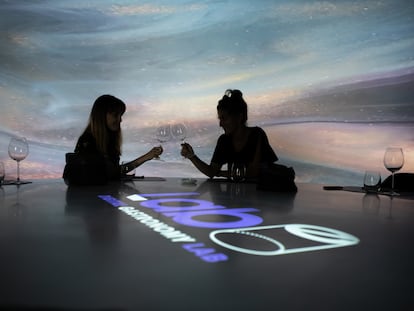The family of artisans who have conquered the best restaurants in the world with their wooden spoons and plates
The Sangiovanni-Lorenzos make hand-crafted tableware for some of the most renowned spots in the world, from Casa Dani in New York, to José Andrés’ establishment in Washington

Fernando Sangiovanni, 61, was once a painter. He lived with his partner, Isabel Lorenzo, in Montevideo, Uruguay. Isabel’s father had a clothing factory. She had studied Business Administration to manage it. But, in 2002, an economic crisis left half of South America without work. “The only hope was at the airport,” Fernando jokes.
The family hosts EL PAÍS in the Sangiovanni showroom. Their brand is behind much of the wooden cutlery and crockery that triumphs on the tables of some of the most famous restaurants in the world. They’re based in the city of Santiago de Compostela, in northwestern Spain, but the family’s bowls, spoons and plates travel to five continents.
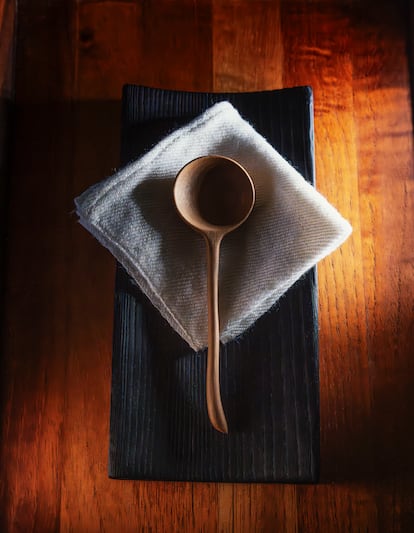
When they decided to move to this city, they had three small children: Joaquín — who was 11 — Camila and Agustín, the baby, who was only five-years-old. Today, they are 32, 30 and 27-years-old respectively. The youngest one is as cordial as everyone else in his family, but he sounds a bit different: he has lost the melodic Uruguayan accent.
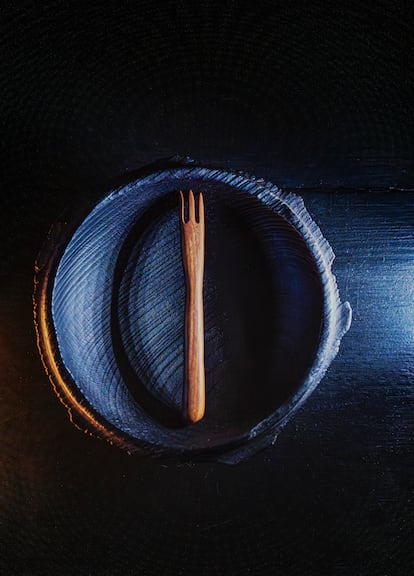
Isabel’s story is, in reality, a story of going back-and-forth. She was born in Carballo, in the Spanish province of A Coruña, to Galician parents. They returned to Montevideo when she was six-months-old. That’s why, when the economic crisis hit, the couple thought that Spain would be a good place to raise their children. “Any emigration is the most difficult journey… you start from scratch,” explains Fernando. Actually, they started out with candles. They made them by hand and sold them at craft markets. And, when sales weren’t so great, they decided to open a pumpkin business.
“It’s one of the symbols of pilgrims. We carved them and emptied them,” Fernando shrugs. Isabel became an artisan alongside him. And, when craftsmanship wasn’t working out, Fernando “ended up as a waiter,” while his wife became a domestic worker. She also went back to school.
Their children quickly became integrated. “That worked out for us,” Fernando admits. Today, Joaquín — the eldest — feels like he’s at home on both sides of the Atlantic, while Agustín, the youngest, feels totally Spanish. “He’s also lived in London and Barcelona, but integration depends a lot on each person’s character,” his father points out.
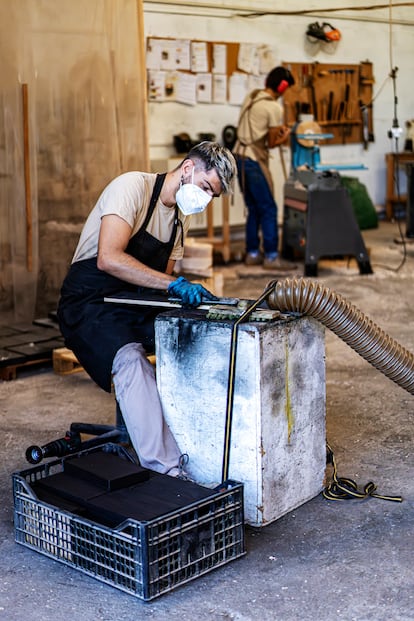
It was in 2015 when the eldest son, Joaquín, finished his carpentry studies. When he couldn’t find a job, he went to work in a store. “It was then that we realized that none of the three of us [siblings] were working in what we had studied,” he recalls. Isabel proposed setting up a workshop to make wooden toys, coat racks and cutting boards. “It was a creative job. But low risk. It didn’t open doors. We weren’t doing anything new,” Fernando admits.
In 2017 — after they opened that store in the center of Santiago de Compostela — the Foundation for Galician Craftspeople organized a meeting between chefs and artisans. The family set up their table. “We had a strange one that only had eight sides!” But the items on display made the chefs confident in the family’s skill. “They asked us for containers capable of holding hot sauce. We only had a saw, but we understood that there was a need in the market.”
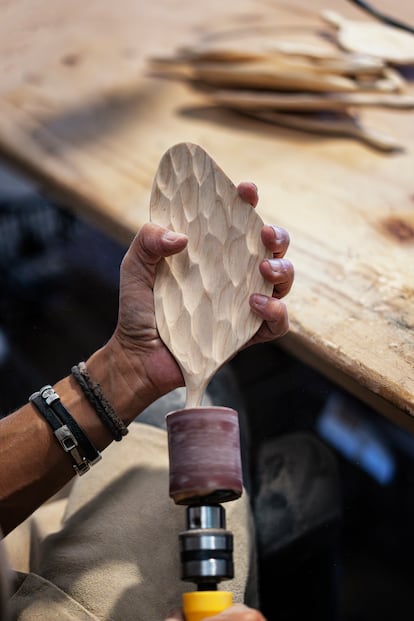
Javier Olleros — from the Wooden Spoon restaurant — asked them for just that: wooden spoons. “There were some organoleptic demands — the flavor or texture of the wood couldn’t be mixed with what he cooked — and we got to work,” Fernando continues.
“We made them differently, sanding the walnut wood in a different way. We took them to him, he tried them out… and he rejected them. We were testing for six months, but we finally achieved what he wanted. This made us see that we could apply the same requirements to other pieces,” Joaquín adds. “We understood that a spoon used to serve teardrop peas in a single bite shouldn’t permeate either the texture or the flavor of what it serves.”

And how did they achieve this? “By sanding,” Joaquín replies. From that spoon, the Sangiovanni-Lorenzos saw other possibilities. “We never said no. Although it wasn’t profitable, it taught us a lot,” Isabel explains. She illustrates this with the example of charring wood. “We knew that it was a Japanese technique from the 16th century. Bringing that to gastronomy — without contaminating the food — was our challenge.” They achieved this by stopping the heat, removing the excess carbon and fixing what was darkened with food oils. “We were innovating. Working in crafts is aspiring to create without limits,” Fernando smiles.
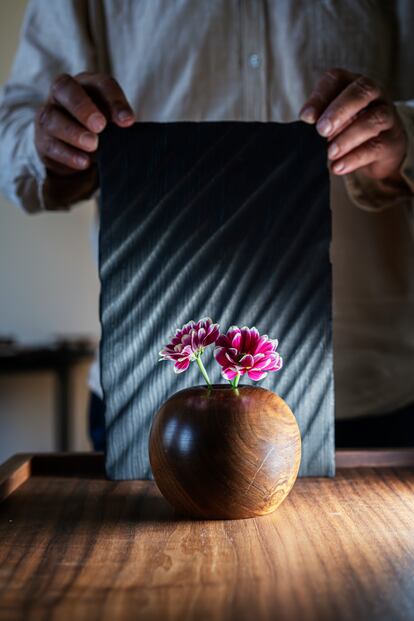
The spoons changed their lives. “All chefs visit other restaurants. And, the first thing they do, when they like a piece, is to turn it over and look for the signature. That’s why we learned that no piece can leave here without our name.” The name is a mess. They’re the Sangiovanni family, and, at the same time, they’re called Lorenzo Design. Fernando admits that they were advised against that double name. But he romantically maintains that “it’s a tribute to our ancestors. It’s a feeling. Sangiovanni is the hand that makes the pieces and Lorenzo is the one that markets them.” Thanks to — or despite — those two names, they’ve come very far indeed.
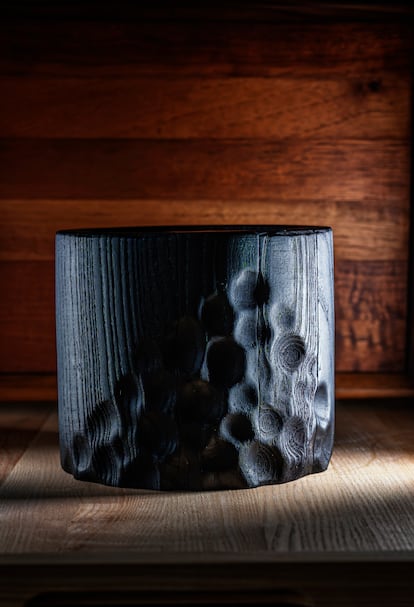
Agustín, the youngest son, studied Physical Education. He lived in London and returned to Santiago with Covid. “I’d been home for three months when the family asked me to join the co-op.” The co-op is almost a utopia. Everyone has the same salary: the property is divided among four owners and employs six workers. “Some earn more than us,” Isabel explains. “It all depends on their skill level and the month. Our salaries fluctuate — not theirs. As the co-op’s owners, we have to take risks. They, as workers, have the right to their salary.”
Agustín was learning the trade when he discovered how neglected their website was. He focused on improving it, which has been essential for the cooperative’s international expansion. With wooden crockery and cutlery in several restaurants in Spain, in 2018, they opened their showroom (where we interviewed them) on the outskirts of Santiago de Compostela. Subsequently, they began to export to Europe, the United States and parts of Asia. Their tableware can be found in exclusive restaurants, such as Mirazur along the French Riviera, Condividere in Milan, Bambola in Chicago, Casa Dani — by Dani García — in New York, José Andrés’ establishment in Washington, or at the Raffles Hotel in London.
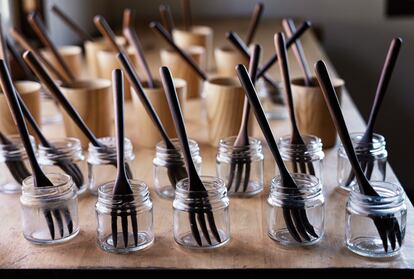
“We release an annual catalog and, at the same time, we work a la carte, exclusively, on orders,” Fernando explains. “For ethical reasons, within the same city, we don’t sell the same pieces from the catalog to multiple restaurants. It’s a personal decision.”
Orders are small. In haute cuisine, there are only between 10 and 20 tables. The establishments order between 20 and 40 pieces of tableware per seat.
And how is the wood treated so that it lasts? Well, the co-op uses European woods: walnut, oak, ash and cherry. Fernando and Joaquín also note that, with each new contract, they ask for time to do their research. For instance, when the restaurant Mugaritz — located in the heart of the Basque Country — asked for a light bowl that could remain stable despite changes in temperature, the family searched for the type of wood that could meet these requirements, while still managing to maintain the aroma of the food. The best match turned out to be Canadian cedar.
This custom work is part of their craftsmanship. “[The client] explains their idea to us… and we have to translate it into wood.”
And do the chefs they work with know about wood?
“They know what they want — they define the use,” Joaquín nods. “Our job is to propose the wood, the finish and calculate the thickness of the edges. And then make the piece, of course.” Sometimes, the family will advise against certain uses of the tableware. “A wooden glass must only be for water. With wine, it may not hold up, despite the natural varnishes.”

The work is completely handmade. They only use a machine to mark the pieces, giving them the name Sangiovanni. They take risks with daring designs. “Like haute couture models,” Fernando says. They’ve also started to make furniture, from benches to lamps.
Then, there’s the challenge of sustainability, especially considering that restaurants continually need to change things up (including their tableware). That’s why the Sangiovanni-Lorenzos offer to repair and conserve the pieces they’ve sold. They can also transform them.
“A cutting board can be transformed into plates or spoons. It can result in new pieces that are born without accumulating or using more raw materials,” Isabel says, demonstrating some old cutting boards, from which the worn edges were cut. “Sometimes, we advise hydration with wax — other times, repair. And, sometimes, replacement.” A part of their proposal for a sustainable economy involves conversations with the chefs about renting some of the kitchenware pieces on a seasonal basis. “This way, they don’t accumulate damaged pieces and we can recycle them later.”

In total, there are 10 people in the workshop. And they don’t want to grow. “We’ve made it clear that not just anyone can work here. We share a lot. We have creative ambition: the desire to continually learn. Because, when we know how to do something, we think of changes,” Isabel says.
They’ve gone to eat in a few of the restaurants that use their tableware. “We have plates in Dubai, in Denmark… selling to a Nordic restaurant is like selling ice to the [Inuit],” Fernando jokes. But they’ve managed to do this for three years, with their clients at the Brace restaurant in Copenhagen. More than 200 restaurants that use pieces by the Sangiovanni-Lorenzo family have at least one Michelin star.

Sign up for our weekly newsletter to get more English-language news coverage from EL PAÍS USA Edition
Tu suscripción se está usando en otro dispositivo
¿Quieres añadir otro usuario a tu suscripción?
Si continúas leyendo en este dispositivo, no se podrá leer en el otro.
FlechaTu suscripción se está usando en otro dispositivo y solo puedes acceder a EL PAÍS desde un dispositivo a la vez.
Si quieres compartir tu cuenta, cambia tu suscripción a la modalidad Premium, así podrás añadir otro usuario. Cada uno accederá con su propia cuenta de email, lo que os permitirá personalizar vuestra experiencia en EL PAÍS.
¿Tienes una suscripción de empresa? Accede aquí para contratar más cuentas.
En el caso de no saber quién está usando tu cuenta, te recomendamos cambiar tu contraseña aquí.
Si decides continuar compartiendo tu cuenta, este mensaje se mostrará en tu dispositivo y en el de la otra persona que está usando tu cuenta de forma indefinida, afectando a tu experiencia de lectura. Puedes consultar aquí los términos y condiciones de la suscripción digital.
More information
Archived In
Últimas noticias
Most viewed
- Sinaloa Cartel war is taking its toll on Los Chapitos
- Reinhard Genzel, Nobel laureate in physics: ‘One-minute videos will never give you the truth’
- Oona Chaplin: ‘I told James Cameron that I was living in a treehouse and starting a permaculture project with a friend’
- Why the price of coffee has skyrocketed: from Brazilian plantations to specialty coffee houses
- David King, chemist: ‘There are scientists studying how to cool the planet; nobody should stop these experiments from happening’


